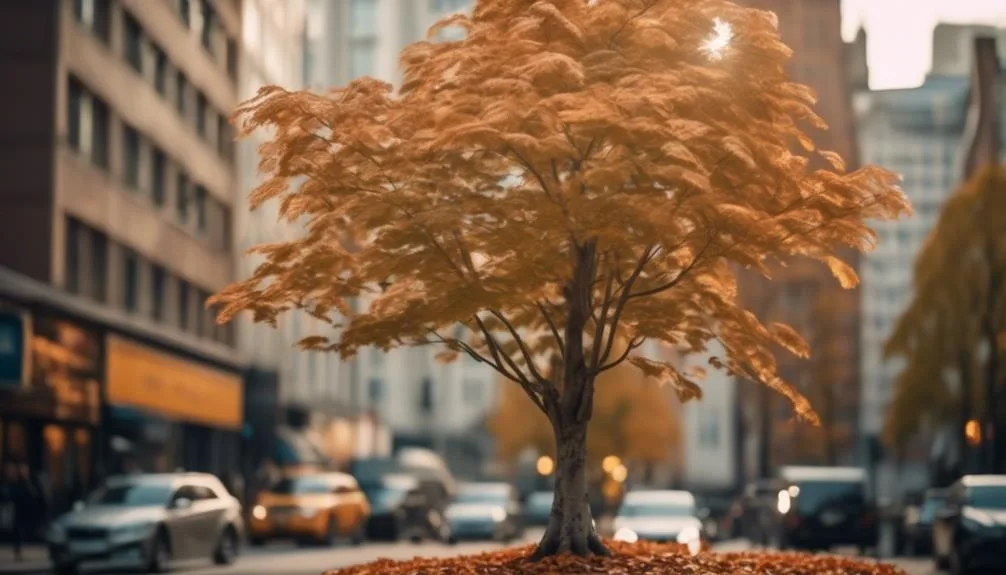Beech trees have thrived in cities for centuries, adapting to urban life. Various factors affect their growth in this environment. Understanding how beech trees cope in urban areas and the challenges they encounter can shed light on their potential in city landscapes.
Let's explore the complexities of cultivating beech trees in urban environments to ensure their success amidst city life's hustle and bustle.
Beech Trees Adaptability to Urban Environments
Beech trees exhibit remarkable adaptability to urban environments, thriving amidst the hustle and bustle of city life while providing essential ecological benefits.
Despite urban pollution, beech trees play a crucial role in improving air quality as they filter out pollutants and release oxygen. Their dense tree canopy provides shade, reducing the urban heat island effect and helping to cool the surrounding environment.
The ability of beech trees to withstand urban pollution and thrive in city landscapes makes them valuable contributors to urban ecosystems. Their adaptability not only enhances the aesthetic appeal of urban areas but also supports biodiversity by providing habitats for various species.
This resilience underscores the importance of preserving and cultivating beech trees in urban environments to maintain ecological balance and improve urban living conditions.
Factors Affecting Beech Tree Growth in Cities
When cultivating beech trees in urban environments, it's essential to consider various factors that can influence their growth and overall health.
Soil quality plays a crucial role in the successful development of beech trees. Urban areas often have compacted or poor-quality soil, which can hinder the tree's ability to establish a healthy root system.
Pollution, including air and soil pollution, can also negatively impact beech tree growth, leading to stunted development and leaf discoloration.
Additionally, tree spacing and pruning are important factors to consider in urban environments. Proper spacing allows for adequate sunlight and airflow, while regular pruning helps maintain the tree's shape and health.
Best Practices for Growing Beech Trees in Urban Areas
To ensure the successful growth of beech trees in urban areas, it's crucial to implement best practices that address soil quality, pollution, tree spacing, and pruning.
Urban soil often lacks essential nutrients, so it's important to enrich it with organic matter and fertilizers. Regular tree maintenance, including watering and mulching, is vital for combating the effects of pollution.
Proper tree spacing is necessary to avoid overcrowding and ensure each beech tree has enough space to thrive. Additionally, pruning helps maintain the health and shape of the trees, allowing for better air circulation and sunlight penetration.
Challenges of Cultivating Beech Trees in Urban Settings
Amidst the bustling urban landscape, challenges arise in the cultivation of beech trees, presenting obstacles that demand innovative solutions for successful growth and sustainability.
Urban pollution poses a significant threat to the health of beech trees. High levels of air pollution, including vehicle emissions and industrial by-products, can hinder the trees' ability to photosynthesize and can lead to leaf damage.
Additionally, soil compaction is a major concern in urban settings. The constant pressure from foot traffic and heavy machinery causes the soil to become densely packed, restricting the movement of water, air, and nutrients to the tree's roots. This can lead to stunted growth and increased susceptibility to diseases and pests.
Overcoming these challenges requires careful planning, including the implementation of green infrastructure and the use of specialized soil management techniques to create a conducive environment for beech tree cultivation in urban areas.
Benefits of Beech Trees in Urban Landscapes
Nestled within the urban landscape, beech trees offer a host of benefits that contribute to the health and well-being of the city environment. These majestic trees provide significant environmental impact by improving air quality, reducing urban heat island effect, and increasing biodiversity. Their dense foliage and extensive root systems help in capturing pollutants, thereby purifying the air and mitigating the effects of pollution. Furthermore, beech trees serve as natural cooling systems, shading buildings and reducing energy consumption. Their presence also promotes community engagement, creating green spaces for recreational activities and fostering a sense of connection to nature. Below is a visual representation of the benefits of beech trees in urban landscapes:
| Environmental Impact | Community Engagement | Health Benefits |
|---|---|---|
| Air purification | Green spaces for recreation | Natural cooling systems |
| Biodiversity support | Connection to nature | Pollution reduction |
Conclusion
In urban settings, the adaptability of beech trees is evident, although their growth may face challenges due to pollution and limited space. Careful attention to watering and soil management is essential for their thriving.
Despite these obstacles, the presence of beech trees in cities offers valuable benefits, including improved air quality and ample shade.
This prompts us to consider the vital role of urban greenery in enhancing our surroundings and well-being.

My interest in trees started when I first saw the giant sequoias in Yosemite.
I was a teenager then, and I remember thinking, “I need to learn more about this.”
That moment stuck with me.
A few years later, I went on to study forestry at Michigan Tech.
Since graduating, I’ve worked in a mix of hands-on tree care and community education.
I’ve spent over ten years helping people understand how to plant, maintain, and protect the trees in their neighborhoods.
I don’t see trees as just part of the landscape.
They are living things that make a real difference in our daily lives.
